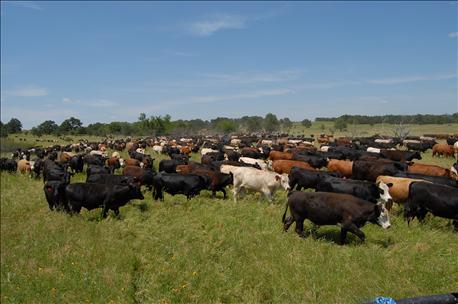
I am convinced the beef industry focus of the past 100 years has been utterly wrong.
Our error is we have always focused on individual animals and their performance, although that performance has been measured through different lenses at different times.
 A high sustainable stocking rate, meaning well-managed grazing that helps lower overall costs, is one key to higher net profit.
A high sustainable stocking rate, meaning well-managed grazing that helps lower overall costs, is one key to higher net profit.
Here's one example: In the old days before dwarfism, breeders worked to create animals that were efficient under an extensive grazing system and to some degree breeders then selected them based on their looks, which naturally led to smaller, more efficient body type and metabolism. This led academics and others in the show ring to over-emphasize what they identified as a "compact" look which actually sprang to some degree from cattle in the Old World and more so in the western US surviving out on range with no inputs and being culled for failing to produce. The idea of breeding a compact cow or compact bull was the wrong goal, dwarfism notwithstanding. Operational profit was ultimately ignored.
After dwarfism ravaged both major breeds (Hereford and Angus), then it was off to the races as we decided to make cattle larger again in response to letting the pendulum of industry opinion swing too far in the smallish-cow direction. Bigger was better and a bigger cow would obviously produce a bigger calf. After all, we get paid by the pound, right?
These days we've half-learned a lot of what we knew was right wasn't really right after all. But we're still focusing on the individual cow and her individual calf as the key to ranch profits.
With that concept firmly in mind, let me ask you this: What is your greatest expense or investment on your ranch?
Hint ... it's not your cows, nor is it any other cattle.
It is land. It's long been held the cost of operation for ranches is roughly equal all across the United States based on a cow unit. It costs about the same for land to run a cow in Arizona as it does in North Dakota or East Texas.
A recent publication on key performance indicators from economist Stan Bevers in Texas says the land cost per cow is in the range of $7,500 and $12,500.
To put this in perspective, if you paid top prices for bred heifers or bred cows in the past couple years -- let's say the relatively high price of $2,800 each -- then it will take $7,500 to $12,500 worth of land to graze them using traditional management.
If you buy into the mantra I chant consistently and you sustainably double your stocking rate through grazing management, your cost will still be $3,750 to $6,250 per cow. If you keep at it and sustainably triple your stocking rate, you will then be spending $1,875 to $3,125 per cow.
And that's just the cost side of the equation. It does lead toward the point I want to make, however. We should focus above all on overall net profit, and on net profit per acre, before we focus on performance or even net profit of cows.
It makes a lot of sense when you think of this analogy by Johann Zietsman, the African rancher and consultant who advocates maximum sustainable stocking rate as the first key to high net profits. Zietsman said if corn farmers were like cattle ranchers they would try to produce the most corn kernels per plant. Then would space the plants out in the field to give them the greatest opportunity to produce the most ears and kernels. In the process, they would go broke.
Instead, corn farmers try for the highest optimum yield per acre and production from each plant is required, but not maximized. Plants per acre is kept as high as possible while giving each plant just enough space and nutrients to produce that big crop, and hopefully do it at the lowest reasonable cost.
Of course, beef producers have some potential advantages over corn farmers when it comes to sustainable and low-cost production, but they're gaining fast with this soil health movement.
Next week I will point out some of the other areas I firmly believe per-cow performance and even per-cow profit has let us into dark waters and red ink.
About the Author(s)
You May Also Like




